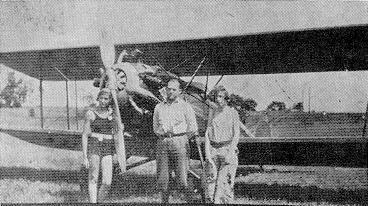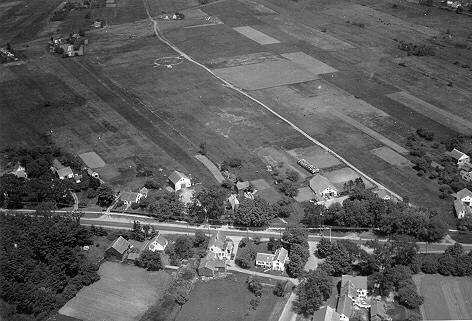Driftway Was Flying Field
The Merchants Review
Thursday, July 18, 1963

between High Street and Winnacunnet Road,
east of today’s Moulton Road.
HAMPTON — Routine action by selectmen recently brought to light the history of an old “driftway” and led to the picture at left, loaned to us by Mrs. Helen Hayden, town clerk.
The picture was taken in 1930 when the Morningside Drive, Eastmore and Holly Lane sections were known as the old “flying field.” High Street can be seen in the background.
The action taken by selectmen was routine. They authorized Town Counsel John Perkins to do away with a “driftway” located between High Street and Morningside Drive and about 10 feet wide.
A driftway, according to town records, is a strip of land to be left for cattle or other animals to cross or use.
This strip was designated about the time that the development of Morningside Drive and adjacent streets began, several years ago.
Before that time, in the early 1920’s, the whole area was pasture land and was called the “flying field.” It was used by the small “mosquito” type airplanes of that era.
This area was one of the first to be developed in the town’s population boom. Ironically, many of the residents now living there are airplane pilots.
Judge Perkins will look into the problem of selling the drift way. Town Manager Kenneth D. Boehner said present abutters would in all probability have first choice.
Quoting from Peter Randall’s Hampton: A Century of Town and Beach, 1888-1988, Chapter 12 — Part 5, (1930 – 1939), 1934: “Voted to lease land between Winnacunnet Road, Locke Road, and High Street for an airport, using $1,000 in federal funds. The airport lasted until World War II. In 1945, the new Hampton Airport opened in North Hampton, operated by Henry Dupuis of Hampton and David Clemons of Newburyport.”
Again, quoting from Randall’s History of Hampton, Chapter 20, “SPORTS”, he further explains about the early Hampton Airfield and later, in 1945, the establishment of the new Hampton Airport, just east of Lafayette Road, and partially in both Hampton and North Hampton:
“….. Although not an athletic activity, flying airplanes has long been a sport for Hampton men and women. Pioneer aviator Harry N. Atwood flew his biplane over the town in May 1912 en route from Saugus, Massachusetts, to Portland, Maine. According to the newspaper, he came in low over the eastern part of town, then flew over the village “close enough to inspect the Dearborn monument. This was the first view of an aeroplane for many people in town.” A few months later, people got a closer look at the plane when Atwood landed on the Hampton River in July. While flying along the coast, he had become lost in a fog bank off Rye Beach, circled around, and finally recognized Hampton River, where he landed. A highlight of the 1915 Carnival Week was aviator J. Chauncey Redding, who performed aerial stunts off the beachfront and took passengers for rides. For many years, Bob Fogg and his airplane were a popular attraction at the Beach, landing on the sand to pick up passengers for sightseeing trips.
IN MEMORIAM
TWO AVIATORS DIE IN FALL AT LYNN, 1915
Biplane collapses – bodies found buried in mud of Massachusetts marsh.
Newsclipping from unidentified paper
Courtesy of Joe Sanford, 1-3-03
“Lynn, Mass., Oct. 21 – J. Chauncey Redding, of Melrose, and Philip Bulman, of Malden, were killed today by the fall of a biplane in which they were making an experimental flight.”
Redding, who was the manager of the Saugus Aviation School, was the operator of the machine and Bulman was his mechanician. They had risen from the aviation field and were soaring over the marshes nearby when the wing framework appeared to collapse and the machine dropped.
Both men were buried to a depth of two feet in the soft mud of the marsh and were dead when taken out.
In the home of Redding, in Malden, the police tonight found several imitation bombs and at Bulman’s home a broken parachute. According to District Attorney Sullivan, neither Redding or Bulman had an aviators license.
For the last two weeks the boys have been at the Saugus Aviation Course. Their biplane, equipped with a 60-horsepower engine, had made many flights, and from it Bulman had made a parachute jump in Boston, a year ago, landing on the common.
A few weeks ago Bulman was at Brockton, where he was to do a parachute jump with James Olsen, the latter deciding to make the flight alone and was killed for his pains when a gust of wind overturned the plane. On July 6, at a celebration in Malden, Bulman made a parachute jump which resulted in his sustaining a broken ankle, and the flight he made this afternoon was the first since that time.
Redding was the son of an electrician and had for some time practiced aviation, and expected to become a member of some aviation corps in Europe.
toward High Street. The open field was Hampton’s first airport,
but the area was heavily developed after World War II.
“Hampton Union editor Charles Francis Adams was an early advocate of building a Hampton airport on the marsh, which he hoped would become a major international facility. His plan was unworkable for a small town, but eventually, various people became interested in the idea of a small airport. In February 1927, the newspaper mentioned an airplane landing in back of Winnacunnet Road, the site of the “proposed new Hampton Aviation Grounds ….” The following August, residents learned that “An aeroplane has recently been stationed in the large field back of Henry Hobbs’s house on High Street. The pilot [unnamed] has been offering rides to residents but on one landing [the plane] hit a rut and broke its propeller.” A few weeks later, in September, a barnstorming flying show was based at the A. T. Johnson flying field. Using three planes, the pilots did aerobatic stunts over the town and the Beach, performed wing walking, and offered rides. These stories give different locations for the airport, but it was in fact situated in the great field between High Street and Winnacunnet Road, east of today’s Moulton Road. Named for its first owner, James Hutchings, the facility was expanded in the spring of 1931. In July, the first passenger to come to Hampton by airplane arrived from the East Boston airport, then went by car to his cottage at the Beach.
“In 1933, a special town meeting, held to seek federal funds that had been made available because of the Depression, authorized the Town to seek $2,500 for the airport and to lease land from the many property owners at the rate of $1 per year plus a rebate of their taxes. Similar airport projects were underway in Portsmouth, Lowell, and Newburyport. World War II brought an end to the airport. Postwar housing developments occupied the site, and in 1946, the current “Hampton” Airport opened in North Hampton.”
